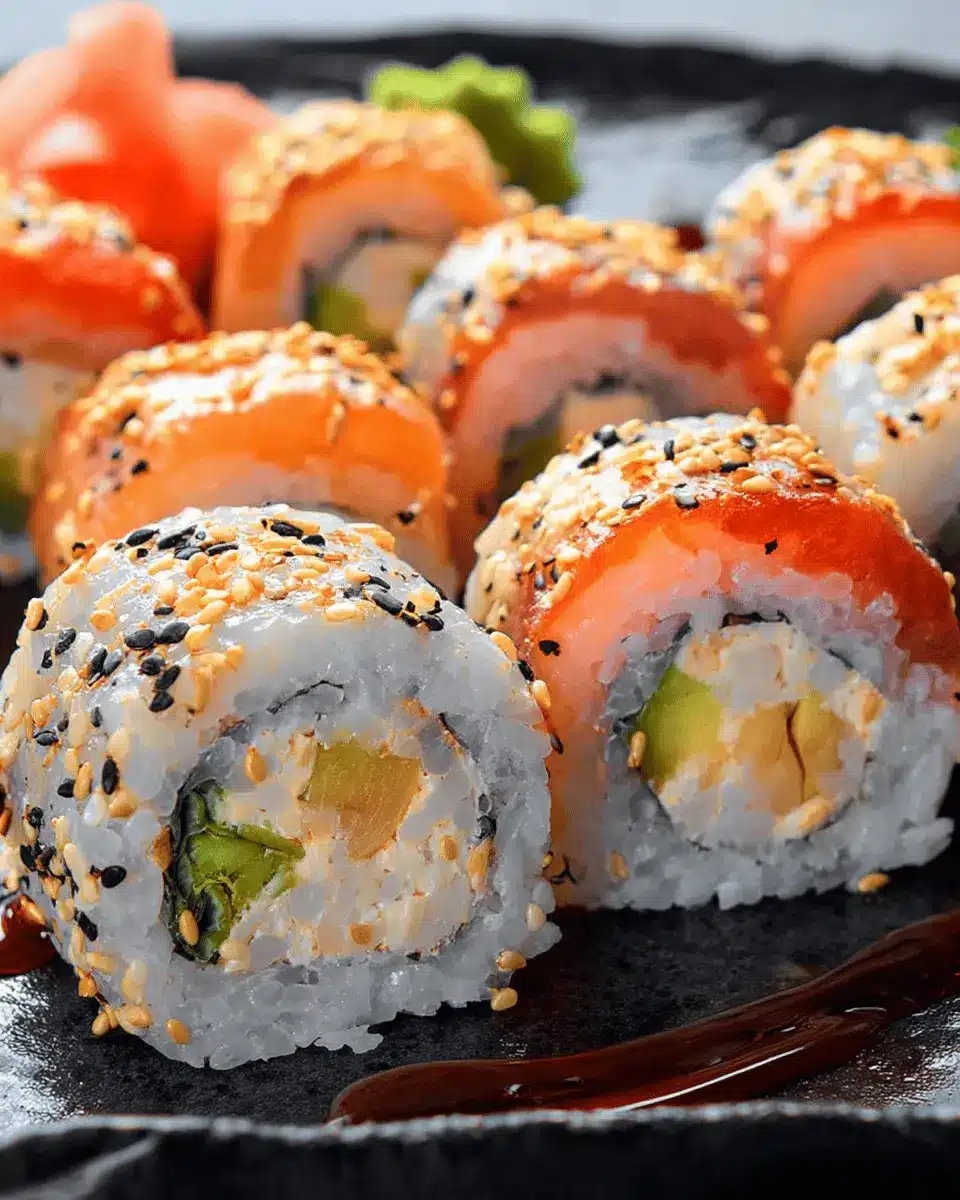Introduction to Maki Sushi Rolls
Maki sushi rolls, or makizushi, are often the first thing that comes to mind when we think of sushi. They are not only visually appealing but also delicious and versatile. If you're contemplating making sushi at home, you’re in for a treat! These rolls allow you to unleash your creativity by using a variety of fillings that suit your taste.
Why Maki Sushi Rolls are a Great Homemade Choice
Making maki sushi rolls at home is an exciting culinary adventure that can be both fun and rewarding. Here are a few reasons to consider whipping up these delightful rolls in your kitchen:
-
Customization: You can tailor the ingredients to your preferences and dietary needs. Whether you're a fan of fresh fish, crunchy vegetables, or savory protein alternatives, the possibilities are endless.
-
Freshness: Homemade sushi means you control every aspect, ensuring the freshest and highest-quality ingredients are used. This is especially important when it comes to seafood, as freshness can dramatically affect the flavor.
-
Social Experience: Rolling sushi can be a fantastic group activity! Gather friends or family, set up a sushi-making station, and enjoy the process together — it’s akin to a mini party right in your dining room.
For more insights on sushi-making techniques, you can also check out Noma's guide to sushi, a culinary authority renowned for its innovative cuisine. Dive into making these delightful maki sushi rolls, and don’t be surprised if they become a staple in your home cooking repertoire!

Ingredients for Maki Sushi Rolls
Essential ingredients for the perfect roll
To create delightful maki sushi rolls, you'll need a handful of essential ingredients that bring flavor and texture together. Here’s what you should gather:
- Sushi Rice: 100g of sushi rice is the base for your rolls, as it sticks well.
- Nori Seaweed: One sheet is perfect for wrapping your ingredients.
- Sushi Vinegar: 2 tablespoons will enhance the rice's flavor, making it slightly tangy and delicious.
- Accompaniments: Don’t forget soy sauce, wasabi, sushi ginger, and optional roasted white sesame seeds for added crunch.
Recommended fillings for a tasty experience
When it comes to fillings, the sky’s the limit! Experiment with various combinations to suit your taste. Some popular choices include:
- Sashimi-grade tuna or salmon: Fresh and full of flavor.
- Avocado: Creamy, it complements the fish beautifully.
- Cucumber: Crunchy and refreshing.
- Crab sticks or canned tuna mixed with mayo: Great for a quick and easy option.
- Prawns: For a touch of sweetness.
Feel free to mix and match these ingredients, defining your unique flavor profile for your homemade maki sushi rolls! For more inspiration, check out this sushi filling guide.
Step-by-Step Preparation of Maki Sushi Rolls
Crafting your own maki sushi rolls at home is not only a fun culinary adventure, but it can also impress your friends and satisfy your sushi cravings. With a little practice and creativity, you can customize your rolls to suit your taste. Let's dive into the process together!
Preparing the sushi rice
Start by preparing the sushi rice. Rinse 100g of Japanese white rice under cold water until the water runs clear. This helps remove excess starch and creates that perfect sticky texture. Cook the rice according to the package instructions, usually in a rice cooker or pot, using the absorption method. Once cooked, transfer the rice to a bowl and gently fold in 2 tablespoons of sushi vinegar, ensuring the rice is still warm. This combination gives the rice that signature taste and sticky quality vital for rolling.
Setting up your sushi rolling mat
Before you start assembling your rolls, lay out a clean workspace and set up your sushi rolling mat. Place a sheet of cling film on top of the mat to make cleanup easier, as sushi rice can be quite sticky. Ensure you have everything you need within reach—your rice, fillings, a sharp knife, and a bowl of water.
Arranging the nori seaweed
Now, it’s time to work with the nori. Take a sheet of nori seaweed and place it shiny side down on your rolling mat. The nori should be aligned horizontally, with one edge facing you. This is your canvas for creating delicious maki sushi rolls. Cover about two-thirds of the nori with the prepared sushi rice, spreading it evenly to about 1cm high, leaving the top third of the nori bare.
Adding your chosen ingredients
The fun part comes next: adding your fillings! This is where you can let your creativity shine. You might use combinations like sashimi-grade tuna, avocado, and cucumber, or even crab sticks mixed with mayo. Lay your chosen ingredients in a line down the center of the rice-covered nori. Don’t overfill; a well-balanced roll is easier to handle and tastes better!
Rolling your sushi with precision
Here's where the magic happens! Using the edge of the mat closest to you, begin to roll the nori away from you while simultaneously applying gentle pressure to keep the ingredients snugly packed. As you reach the edge of the nori without rice, moisten it with a little water to help it seal. Keep rolling until your sushi forms a tight cylinder.
Cutting and plating your sushi rolls
Once you've successfully rolled your sushi, it’s cutting time! With a sharp, wet knife, slice your roll into 6-8 pieces, wiping the knife clean between cuts. This makes for beautiful, uniform pieces. Arrange your maki sushi rolls on a plate and serve them with soy sauce, wasabi, and sushi ginger for the full experience. A sprinkle of roasted white sesame seeds can add a lovely touch!
Now that you’ve mastered the art of making sushi, why not explore other sushi styles like uramaki or futomaki? Each variation brings its own exciting twist to the table! Happy rolling!

Variations on Maki Sushi Rolls
Futomaki vs. Hosomaki: What's the difference?
When it comes to maki sushi rolls, you’ll often hear about two main styles: futomaki and hosomaki. But what sets them apart? Futomaki are thicker rolls filled with a delightful medley of ingredients—think cucumber, avocado, and salmon all snugly wrapped together. These rolls are bold and hearty, making them perfect for those who enjoy variety in every bite. On the other hand, hosomaki are the slimmer counterpart, typically featuring just one core ingredient, like fresh tuna or crunchy cucumber. Their simplicity not only highlights the quality of the filling but also makes them a fabulous option for sushi purists.
Creative Filling Combinations to Try
While traditional fillings are a hit, it's time to get adventurous! Here are some fun ideas to inspire your next maki sushi rolls creation:
- Spicy Tuna Roll: Mix diced sashimi-grade tuna with spicy mayo.
- Veggie Delight: Combine grilled zucchini, bell peppers, and cream cheese.
- Sweet and Savory: Try a blend of sliced apple, turkey bacon, and a hint of honey.
- Breakfast Sushi: Fill with scrambled eggs, avocado, and a sprinkle of sesame seeds for a morning twist.
Explore these delicious variations and wow your friends at your next gathering! For more creative sushi ideas, check out Just One Cookbook.
Cooking Tips and Notes for Maki Sushi Rolls
Keep Your Fingers Wet While Working
As you roll your maki sushi rolls, keep a small bowl of water nearby. Wetting your fingers prevents the sticky rice from clinging, making the whole process smoother and more enjoyable. Remember, a little moisture goes a long way!
Tips for Cutting Sushi Rolls Cleanly
To achieve clean, professional cuts, use a sharp knife and dip it in water before each slice. This vital tip ensures that the rice and fillings don’t squish out, leaving you with beautifully presentable pieces.
Use Cling Film for Easy Cleaning
Cover your sushi rolling mat with cling film before you start; this simple trick saves time on cleanup. Plus, it keeps your mat free from sticky rice, making future sushi-making sessions even easier!
Experiment with your favorite fillings and enjoy the creative process of making your own delicious maki sushi rolls. For more tips, check out this helpful resource for sushi enthusiasts!

Serving Suggestions for Maki Sushi Rolls
Ideal sides and sauces to accompany your rolls
Maki sushi rolls shine when paired with a variety of delicious sides and sauces. Consider serving your rolls with:
- Soy Sauce: A classic choice, perfect for dipping.
- Wasabi: For that spicy kick that elevates the flavors.
- Sushi Ginger: It cleanses the palate between bites.
- Edamame: Steamed and lightly salted for a nutritious snack.
- Seaweed Salad: Bright and refreshing, complements the sushi perfectly.
Pairing suggestions for a complete meal experience
To create a truly memorable dining experience, think about these pairings alongside your maki sushi rolls:
- Miso Soup: Warm and savory, it offers a comforting contrast.
- Green Tea: Its earthy taste balances the rich flavors of the fish.
- Tempura Vegetables: Lightly battered and fried, they add crunch and variety.
By incorporating these sides and pairing suggestions, you’ll not only elevate your maki sushi rolls but also craft an enjoyable, multi-sensory meal. For more sushi inspiration, check out Japanese Cuisine and Culture.
Time Breakdown for Maki Sushi Rolls
Preparation Time
Getting started with your maki sushi rolls takes about 20 minutes. During this time, you'll prepare your sushi rice, chop your fillings, and set up your workspace—all crucial steps to ensure a smooth rolling process.
Cooking Time
Once your rice is prepped, the cooking time doesn't take long at all, only 15 minutes! This is when you’ll cook the sushi rice properly to achieve that perfect sticky texture, essential for rolling.
Total Time
By adding both preparation and cooking times, you’ll find that the total time for making your delicious maki sushi rolls is approximately 35 minutes. Perfect for a quick, imaginative meal or a fun night in with friends!
For further tips on sushi making, consider checking out Japan Centre's sushi guide for detailed insights!
Nutritional Facts for Maki Sushi Rolls
Calories per serving
A single serving of maki sushi rolls typically contains around 200 calories. However, calories can vary based on fillings and additional sauces used.
Protein content
Enjoy a moderate amount of protein with approximately 10 grams per serving. This can increase significantly with fillings like tuna or salmon.
Sodium levels
Maki sushi rolls can have elevated sodium levels, averaging 500-800 mg per serving, particularly if you're dipping in soy sauce. Opt for low-sodium soy sauce for a healthier choice.
For more detailed insights on healthy sushi, check out Healthline.
FAQs about Maki Sushi Rolls
Can I make sushi without raw fish?
Absolutely! Maki sushi rolls can be filled with a variety of ingredients that don't involve raw fish. Popular options include cooked shrimp, vegetables like cucumber and avocado, or even options like crab sticks or canned tuna mixed with mayo. This makes sushi accessible and fun for everyone, whether you prefer traditional flavors or creative twists!
How do I store leftover sushi rolls?
To keep your leftover sushi fresh, wrap the rolls tightly in plastic wrap and place them in an airtight container. Alternatively, you can store them in a resealable bag, ensuring you remove as much air as possible. Keep them in the refrigerator, and enjoy within 24 hours for the best taste and texture.
What’s the best way to serve sushi at a gathering?
Serving maki sushi rolls at a gathering can be a hit! Arrange the rolls on a large platter, and consider adding some dipping sauces like soy sauce, wasabi, and pickled ginger on the side for guests to customize their experience. For an added touch, garnish the platter with fresh herbs or edible flowers to elevate the presentation.
Conclusion on Maki Sushi Rolls
Embracing homemade sushi in your kitchen
Making maki sushi rolls at home is a fun and rewarding experience. It allows you to be creative with fillings while enjoying a delicious and healthy meal. With a little practice and the right ingredients, you can impress family and friends with your newfound sushi skills. So roll up your sleeves, and let your culinary journey begin!

Maki sushi rolls
Equipment
- sushi rolling mat
Ingredients
Base Ingredients
- 100 g sushi rice
- 1 sheet nori seaweed
- 2 tablespoon sushi vinegar
- soy sauce
- wasabi
- sushi ginger
- roasted white sesame seeds optional
Recommended Fillings
- tuna sashimi grade, raw
- salmon sashimi grade, raw
- avocado
- cucumber
- crab sticks
- canned tuna mixed with mayo
- prawns
Instructions
Preparing Sushi
- Cook Japanese white rice and mix it with sushi vinegar.
- Prepare your sushi rolling mat.
- Place a sheet of nori seaweed on the mat and cover two thirds with sushi rice.
- Add your chosen fillings in a line on top of the rice.
- Roll the sushi using the wooden mat, keeping it tight.
- Cut the roll into 6-8 pieces and serve with soy sauce, wasabi, and sushi ginger.




Leave a Reply